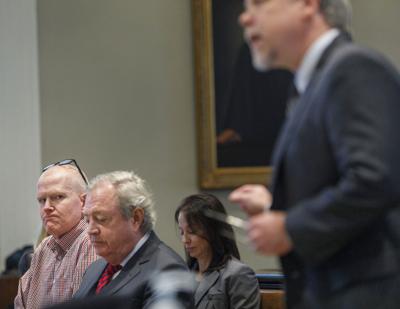Defense attorneys for accused killer Alex Murdaugh on Nov. 23 alleged state investigators manipulated an expert witness into producing a false report that implicates their client in the double murder of his wife and son in June 2021.
In a highly technical, 96-page motion, Columbia lawyers Dick Harpootlian and Jim Griffin took issue with a key aspect of the state’s evidence against their client: the reported presence of high-impact “spatter” on the white T-shirt the disgraced attorney wore the evening he reported finding Maggie and Paul Murdaugh shot to death on the family’s Lowcountry hunting estate.
Experts say such spatter is left on nearby surfaces when a gunshot discharges blood and other matter into the air.
But Murdaugh’s high-powered defense team, having spent the past two months reviewing the state’s evidence ahead of a Jan. 23 trial, now says investigators’ own tests of Murdaugh’s shirt came back negative for human blood in the areas where the state’s expert claims to have observed spatter.
Parts of Murdaugh’s shirt where supposed spatter marks were found also tested negative for Paul Murdaugh’s DNA, even though Murdaugh’s son was shot at close range with a shotgun, the filing states.
The state’s expert, a retired Oklahoma City police officer, initially found Murdaugh’s shirt had no stains “consistent with back spatter resulting from a gunshot” but was pressured by State Law Enforcement Division agents to change his mind before issuing a final report, Murdaugh’s attorneys allege.
And SLED’s lab analysts tested the shirt using unreliable methods that dyed the shirt blue and ultimately rendered it impossible to test further, Murdaugh’s attorneys complained.
Murdaugh’s motion, filed the day before Thanksgiving, is the latest pretrial volley in a murder case that has drawn international attention.
SLED and the S.C. Attorney General’s Office declined to comment on the allegations.
“We are reviewing the motion and will respond at the appropriate time,” SLED Chief Mark Keel said in a written statement.
Attorney General’s Office spokesman Robert Kittle said prosecutors would respond in a court filing next week.
Murdaugh was a respected trial attorney from a prominent Hampton County family before the June 7, 2021, slayings of his wife and son sparked a web of criminal investigations and civil lawsuits that have accelerated his personal unraveling.
He now stands accused of surreptitiously stealing more than $9 million from his former clients, law partners and others who trusted him. Thirteen months after Murdaugh called 911 to report finding his wife and son badly shot outside the hunting estate’s dog kennels, a Colleton County grand jury charged him with the murders.
The Attorney General’s Office has disclosed little about its case against Murdaugh since the July 14 indictment. But bits and pieces have come out in pretrial filings and in open-court exchanges between state prosecutors and Murdaugh’s defense team.
Close followers of the Murdaugh saga have known about high-impact spatter since an April 2022 story on FITSNews.com, based on unnamed sources, revealed it was part of the state’s case against Murdaugh.
The article indicated that the evidence meant Murdaugh “was physically close to one or more of his family members when they were shot.”
Murdaugh’s team has pushed back on that conclusion. Griffin told HBO documentary producers this spring that while impact spatter on hard surfaces, like walls and tables, is considered accepted evidence, it’s “junk science” to draw the same conclusions from droplet marks on clothing.
The Nov. 23 filing from Murdaugh’s team goes a step further, accusing the state of acting negligently or in bad faith as it sought to use spatter to build a case against Murdaugh.
Their filing alleges the state “needs blood spatter evidence because it is exceedingly difficult to explain how Mr. Murdaugh could have murdered Paul with multiple 12-gauge shotgun blasts at pointblank range in a small closet without getting at least some blood spattered on his shirt."
“After all,” it continues, “blood was spattered all over the closet door, walls and ceiling. So instead of accepting an honest exculpatory report, the State changed it to a false inculpatory report.”
Murdaugh’s attorneys alleged SLED agents spoke several times with the state’s hired expert, Tom Bevel of Oklahoma, between his initial report that found no impact spatter stains on Murdaugh’s shirt and his final report nearly two months later that found more than 100 of them.
SLED presented no new evidence to Bevel in the interim, meaning the only thing that changed his mind was investigators’ “relentless pressure,” they wrote. In fact, Bevel's updated conclusions came from examining SLED lab photos of the shirt because the garment itself had been heavily damaged by forensic testing. That damage also prevented the defense from having their own experts examine the shirt, they stated.
“SLED elected to conduct its tests in a manner that would prevent anyone else from conducting subsequent tests," Murdaugh's lawyers wrote.
Reached Nov. 23, Bevel declined to comment.
Their motion asks Judge Clifton Newman to order prosecutors to release more evidence to them, including any communications between SLED and Bevel. It also requests that Newman prevent prosecutors from offering Bevel’s “manipulated opinion testimony” at Murdaugh’s upcoming trial.
The merits of those requests are expected to be debated at a hearing in early December.








